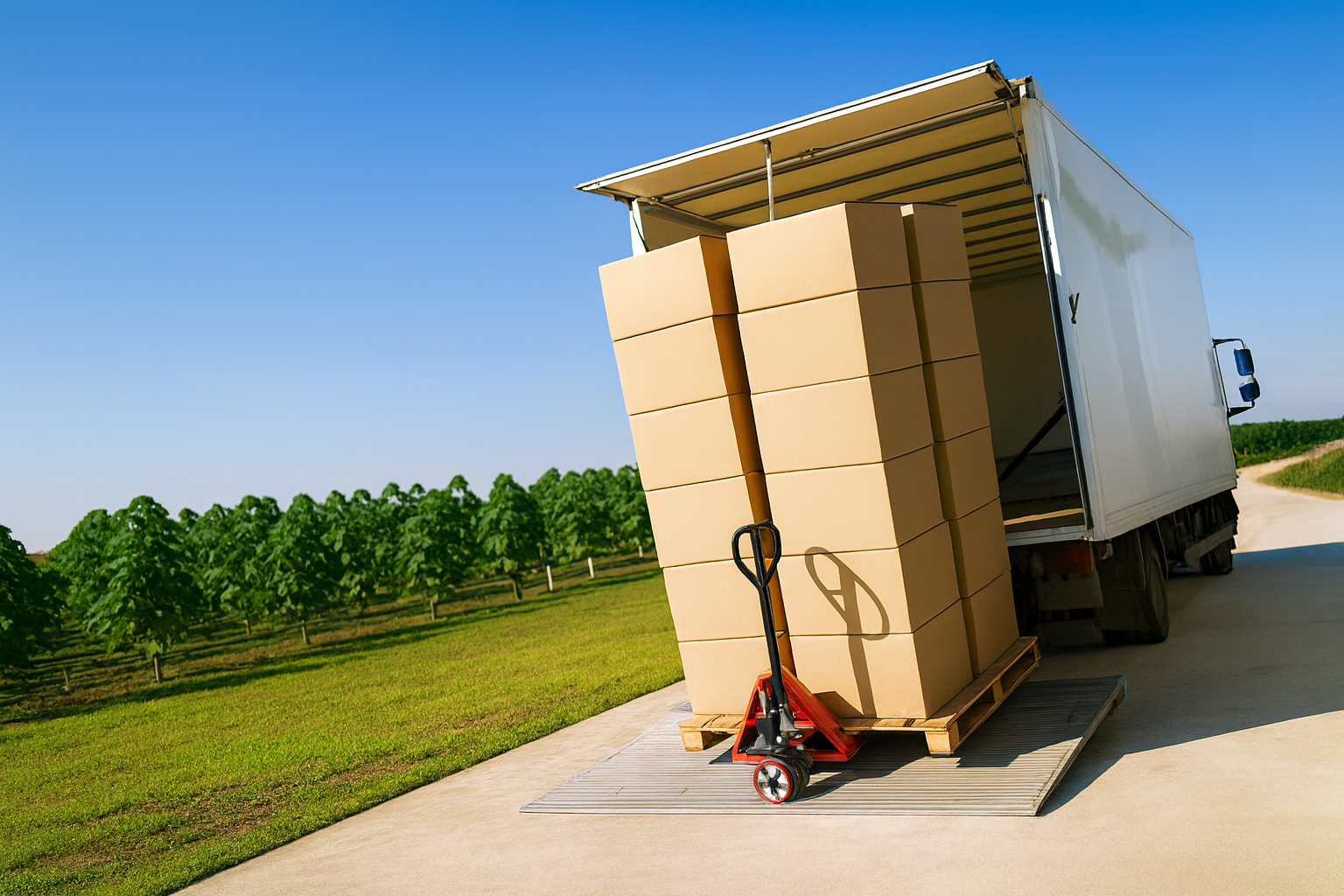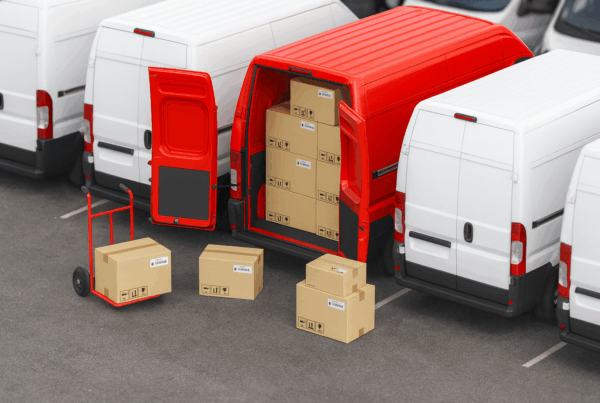LTL transport is a strategic solution for shipping efficiently without filling an entire truck. Unlike FTL (Full Truckload), where a trailer is reserved for a single shipment, LTL (Less Than Truckload) allows multiple shipments to be consolidated into the same truck. This approach optimizes transport space and reduces costs.
At Trans-Inter Logistik, we offer Less-Than-Truckload (LTL) services designed for businesses that ship smaller quantities. In this article, we explain what LTL freight is, how it works, and what advantages it can bring to your supply chain.
What Is LTL (Less-Than-Truckload) Shipping?
LTL freight shipping refers to the transport of goods that don’t require a full truckload. LTL carriers handle palletized goods with expertise, securing items with shrink-wrap packaging to ensure safe transport. Generally, LTL shipments weigh between 150 and 35,000 pounds and take up between 1 and 18 pallets—beyond that, FTL shipping becomes more cost-effective.
At Trans-Inter Logistik, we use a hub-and-spoke model, where local terminals (the spokes) are connected to main distribution centers (the hub). This system allows us to consolidate shipments from multiple clients, maximizing available trailer space and reducing costs for everyone. Whether you’re shipping to the United States, Canada, or Mexico, our team ensures your goods are delivered quickly, reliably, and cost-effectively.
Streamline Your Shipping Process
Why Do Businesses Use LTL Freight Transport?
Less-Than-Truckload (LTL) freight is a flexible and cost-effective solution, ideal for companies that ship smaller volumes. Beyond reducing transport costs, it allows more frequent deliveries, optimizes inventory management, and supports more sustainable operations. Today, LTL freight has become a cornerstone of modern logistics strategies.
1. Cost-effective shipping for small loads
With LTL freight, you only pay for the trailer space your shipment occupies, unlike FTL where you cover the cost of the entire truck. This significantly reduces shipping expenses.
2. Ideal for e-commerce and small businesses
The growth of e-commerce demands flexible shipping solutions. LTL transport enables businesses to ship smaller quantities more frequently, aligning with inventory management needs and lowering warehousing costs. Small businesses also benefit from our expertise as a 3PL provider, accessing professional logistics services without the expense of full truckload transport.
3. Environmentally friendly logistics
By consolidating multiple shipments into one truck, LTL transport reduces the number of trucks on the road, lowering greenhouse gas emissions and your company’s carbon footprint. At Trans-Inter Logistik, we prioritize sustainable practices, making LTL a smart choice for environmentally conscious businesses.
Streamline Your Shipping Process
LTL Transport in Canada: From Pickup to Delivery
Less-Than-Truckload (LTL) freight transport follows a structured process that ensures efficiency, cost control, and on-time delivery. Whether you’re shipping within the country or across the border, each step is designed to optimize routes, consolidate loads, and keep your cargo moving. Here’s how the process unfolds from start to finish:
Step 1: Classification, Pricing, and Documentation
In Canada, domestic shipments are generally priced based on weight, dimensions, origin, and destination. However, if your cargo is crossing the border into the United States, carriers may require an NMFC code (National Motor Freight Classification).
Managed by the NMFTA (National Motor Freight Traffic Association), this system classifies goods by density, stackability, handling, and liability risk, which can affect applicable rates within the U.S.
Even when not mandatory, providing an NMFC code can help Canadian shippers:
- Obtain consistent quotes from cross-border carriers.
- Speed up customs clearance through accurate product descriptions.
- Avoid reclassification fees on the U.S. side.
In all cases, be sure to prepare a Bill of Lading, which serves both as a transport contract and an official receipt for your shipment.
Step 2: Scheduling Pickup and Selecting Services
Canadian LTL carriers offer flexible service options, such as:
- Local pickup and delivery
- Liftgate service for locations without loading docks
- Cold chain solutions for refrigerated goods
- Expedited services for urgent deliveries
These add-on services are billed as accessorial charges and should be included in your freight quote.
Step 3: Moving Through the Network
Most carriers use a hub-and-spoke model:
- Freight is picked up locally and moved to nearby terminals.
- At consolidation centers, multiple shipments are combined into a single truckload.
- Cargo follows an optimized route, which may include multiple transfer points, until it reaches the destination terminal.
This approach reduces fuel consumption, minimizes environmental impact, and helps maintain competitive rates, even in volatile markets where external factors, such as decisions by the Organization of the Petroleum Exporting Countries (OPEC), influence diesel prices.
Step 4: Final Delivery
Once freight arrives at the destination terminal, it is delivered within the agreed time frame. Our carriers coordinate with your team to ensure smooth unloading with no surprises.
What Is the Difference Between LTL (Less-Than-Truckload) and FTL (Full Truckload) Shipping?
Choosing the most suitable shipping option depends on your shipment size, budget, and delivery deadline. Less-Than-Truckload (LTL) shipping is designed for smaller, consolidated shipments, while Full Truckload (FTL) shipping dedicates an entire trailer to a single load. Understanding these differences helps you strike the right balance between cost savings, speed, and cargo protection.
- LTL freight shipping is ideal for loads that don’t require a full trailer (generally between 150 and 35,000 pounds).
- FTL shipping, on the other hand, means that one shipment fills the entire truck. This option is faster since there are no intermediate stops for consolidation or sorting. It is better suited for large loads, sensitive goods that cannot be transferred between terminals, or urgent deliveries with tight time windows.
Key Differences Between LTL and FTL Shipping
| LTL (Less-Than-Truckload / Partial Load) | FTL (Full Truckload / Full Load) | |
| Shipment Size | 150 to 35,000 lbs; multiple handling units | Up to ~44,000 lbs; full trailer |
| Trailer Space | Shared with other shippers | Exclusive to one shipment |
| Shipping Rates | Based on weight, dimensions, and distance | Flat rate or mileage-based; weight matters less |
| Transit Time | Longer; multiple stops and transfers | Faster; direct route to destination |
| Liability | Shared responsibility; proper packaging is crucial | More control; lower handling risk |
| Services | Liftgate, inside pickup/delivery, expedited, cold chain, on-site assembly | Fewer add-ons; liftgate optional on some routes |
| Cost Efficiency | Cheaper for small to mid-sized loads | More economical for large volumes or full loads |
| Best Suited For | E-commerce, small businesses, frequent partial shipments | Large loads, fragile or high-value goods, tight deadlines |
Challenges of Less-Than-Truckload (LTL) Freight Shipping
Transit Times and Planning
LTL shipping generally involves routes with multiple stops, which can extend transit times compared to FTL transport. Weather conditions, seasonality, and chosen routes also affect delivery schedules.
To mitigate these variables, our team relies on advanced analytics and Transportation Management Systems (TMS) to optimize routes. We also provide transparent tracking through PRO or PO numbers.
Carrier Capacity and Specific Needs
Not all carriers offer LTL services, and choosing the right partner can be challenging, especially when shipments require specialized handling such as white glove service or temperature-controlled transport.
These services often come with significant additional costs. Thanks to our vast network of reliable partners, we offer tailored solutions that are both efficient and cost-competitive, perfectly suited to your specific needs.
Accuracy of Shipment Information
Incorrect freight classification or miscalculated dimensional weight can lead to extra charges, such as reclassification fees or fuel surcharges. Our brokers ensure each shipment is documented accurately, avoiding costly errors and maintaining strong relationships with carriers.
Streamline Your Shipments with LTL Freight
Best Practices for Optimizing LTL Freight Shipping
Use a Transportation Management System (TMS)
Our next-generation Transportation Management System (TMS) leverages intelligent automation to analyze containers, optimize pallet configuration, and plan highly efficient multi-step routes.
This advanced technology reduces fuel consumption, improves load stackability, and ensures real-time tracking, providing full visibility on every shipment. The result? Your freight arrives on time, within schedule and budget.
Provide Accurate Shipment Information
Precise data entered into the density calculator, including weight and dimensions, helps avoid unexpected charges and insurance complications. We support our clients with proper palletized freight preparation, ensuring secure packaging, clear labeling, and compliance with NMFTA standards where required.
Consider Intermodal Freight Options
For long-distance shipments, our intermodal freight solutions strategically combine rail with LTL services, reducing road transport costs while minimizing environmental impact. This approach is especially advantageous for clients with large volumes to move across state or provincial borders.
Ship Beyond Borders with Confidence
3PL Provider Services for LTL Freight: Frequently Asked Questions
Can LTL freight be combined with courier or parcel delivery services?
Yes. Many companies adopt a hybrid model by combining LTL transport for most of the journey with courier or parcel delivery for the last mile. This approach is especially effective for e-commerce businesses that ship bulk goods to regional centers before optimized local distribution.
What is “groupage” freight and how is it related to LTL?
Groupage freight is very similar to LTL, but the term is more common in Europe and certain regions of Canada. It refers to consolidating shipments from multiple shippers into a single load to share transportation costs.
Can LTL transport move long-distance freight to smaller U.S. destinations?
Yes. For example, a shipment from Quebec to Tomah, Wisconsin, can be handled through a combination of regional and long-haul carriers. Freight may start with a regional operator and then be transferred to larger network partners to complete the route efficiently.
Why choose Trans-Inter Logistik for LTL transport?
At Trans-Inter Logistik, we’re not just a freight broker, we’re a true logistics partner. Backed by deep expertise in LTL freight, advanced analytics technology, and a vast carrier network, we deliver solutions that combine cost savings, reliability, and performance.
Whether you’re shipping standard parcels or hazardous materials, our freight brokers design customized solutions, including specialized services such as white glove handling. Contact us today to learn how our LTL approach can optimize your supply chain, from the first mile to final delivery.
Let’s Plan Your Next Shipment Together







